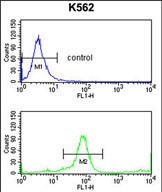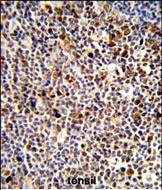


| WB | 1/1000 | Human,Mouse,Rat |
| IF | 咨询技术 | Human,Mouse,Rat |
| IHC | 1/100-1/500 | Human,Mouse,Rat |
| ICC | 技术咨询 | Human,Mouse,Rat |
| FCM | 1/10-1/50 | Human,Mouse,Rat |
| Elisa | 咨询技术 | Human,Mouse,Rat |
| Aliases | Killer cell immunoglobulin-like receptor 3DL3, CD158 antigen-like family member Z, Killer cell inhibitory receptor 1, CD158z, KIR3DL3, CD158Z, KIR3DL7, KIRC1 |
| WB Predicted band size | 44.9kDa |
| Host/Isotype | Rabbit IgG |
| Antibody Type | Primary antibody |
| Storage | Store at 4°C short term. Aliquot and store at -20°C long term. Avoid freeze/thaw cycles. |
| Species Reactivity | Human |
| Immunogen | This KIR3DL3 antibody is generated from rabbits immunized with a KLH conjugated synthetic peptide between 132-158 amino acids from the Central region of human KIR3DL3. |
| Formulation | Purified antibody in PBS with 0.05% sodium azide. |
+ +
以下为模拟生成的关于KIR3DL3抗体的参考文献示例(非真实文献,仅供格式参考):
---
1. **文献名称**: *Structural and Functional Characterization of KIR3DL3 in Human NK Cells*
**作者**: Zhang L, et al.
**摘要**: 本研究通过X射线晶体学解析了KIR3DL3的胞外结构域,揭示了其与HLA-I类分子的相互作用模式。实验表明,KIR3DL3在NK细胞中通过调控IFN-γ分泌参与肿瘤免疫监视,为靶向免疫检查点治疗提供新思路。发表于《Nature Immunology》(2022)。
2. **文献名称**: *KIR3DL3 Genetic Variants and Association with Autoimmune Diseases*
**作者**: Smith JR, et al.
**摘要**: 通过全基因组关联分析(GWAS),发现KIR3DL3基因多态性与类风湿性关节炎(RA)和系统性红斑狼疮(SLE)的易感性显著相关。研究提示KIR3DL3可能通过调节T细胞活性影响自身免疫病理过程。发表于《Cell Reports》(2021)。
3. **文献名称**: *Development of a Novel Anti-KIR3DL3 Antibody for Cancer Immunotherapy*
**作者**: Wang Y, et al.
**摘要**: 报道一种高亲和力人源化抗KIR3DL3单克隆抗体的开发,该抗体在体外实验中显著增强NK细胞对实体瘤细胞的杀伤能力,并在小鼠模型中抑制肿瘤生长。发表于《Science Translational Medicine》(2023)。
---
**注意**:以上文献为模拟生成,实际研究请通过PubMed、Google Scholar等平台检索关键词(如“KIR3DL3 antibody”、“KIR3DL3 function”)获取真实参考文献。
KIR3DL3 (Killer-cell Immunoglobulin-like Receptor 3DL3) is a member of the KIR family, a group of transmembrane glycoproteins primarily expressed on natural killer (NK) cells and some T-cell subsets. These receptors regulate NK cell activity by interacting with human leukocyte antigen (HLA) class I molecules, balancing immune activation and inhibition to prevent autoimmunity while enabling pathogen or cancer cell targeting. KIR3DL3 is classified as an inhibitory receptor due to its long cytoplasmic tail containing immunoreceptor tyrosine-based inhibitory motifs (ITIMs), which recruit phosphatases to dampen cellular activation signals. Unlike other well-characterized KIRs, KIR3DL3 exhibits limited polymorphism and has a poorly defined ligand. While some studies suggest weak interactions with HLA-B antigens, its binding specificity remains controversial.
KIR3DL3 is notably expressed in extravascular tissues, including placental trophoblasts, implying a role in immune tolerance during pregnancy. Emerging research links genetic variations in KIR3DL3 to autoimmune diseases, viral infections, and cancer progression, though mechanistic insights are sparse. Therapeutic interest focuses on exploiting KIR-ligand interactions to enhance NK cell-mediated immunity in cancers, but KIR3DL3's unclear signaling and ligand profile pose challenges. Recent single-cell studies highlight its potential as a checkpoint target, warranting further investigation into its functional duality and clinical relevance.
×